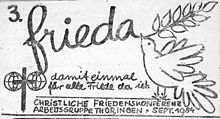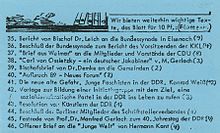Frieda (magazine)
frieda was a quarterly magazine of the Christian Peace Conference , Thuringia Working Group, which was published from April 1984 to September 1992.
The line of her blade wanted the editors in the semantics see expressed her name: "... so that once and for all Fried e d a is".
From the initial 200 copies, the print run increased to 4,000 copies.
Emergence
In the spring of 1984, left-wing Christians and employees of the Christian Peace Conference (CFK) met in the Troistedt rectory to discuss the publication of a document that should stimulate and promote peace work in the Protestant church. An editorial group was formed, which for the next eight years consisted of the following members:
March 1984-May 1985
- Martina Berlich
- Peter Franz
- Wolfgang Kerst
June 1985-February 1987
- Ulrike Baumann
- Peter Franz
- Wolfgang Kerst
March 1987-December 1988
- Ulrike Baumann
- Peter Franz
- Herbert Gerhardt
January 1989-March 1989
- Ulrike Baumann
- Peter Franz
- Manfred Gernand
April 1989-December 1990
- Ulrike Baumann
- Peter Franz
- Wolfgang Kerst
January 1991-April 1991
- Georg Kähler (responsible)
- Jörg Baumann
- Ulrike Baumann
- Peter Franz
May 1991-August 1991
- Georg Kähler (responsible)
- Jörg Baumann
- Ulrike Baumann
- Peter Franz
- Christiane Wagner
September 1991-August 1992
- Georg Kähler (responsible)
- Christiane Wagner
September 1992
- Georg Kähler (responsible)
- Peter Franz
- Christiane Wagner
Content
The magazine referred to events, peace seminars, peace prayers and peace actions. The topics covered also included reviews of newly published books. In addition, song sheets were regularly enclosed containing songs from churches and social movements that conformed to the GDR system. Monetary donations were regularly collected to support a student from Angola who studied Protestant theology at Berlin's Humboldt University and then served as a pastor in his home community.
In contrast to the opposition newspapers within the church, the publishers, the CFK group Thuringia, infiltrated by several unofficial employees of the state security , refrained from fundamental opposition to the GDR state.
In October 1989, the year of political upheaval, the CFK Thuringia published in frieda No. 21 excerpts from the appeals and declarations of some opposition groups such as the New Forum .
Authors
In addition to the editorial members, the authors of the articles included a .: Peter Bauer (Weimar), Günter Gerstmann (Jena), student pastor Detlev Haupt (Erfurt), Christian Heinrich (Erfurt), Johannes Hoefert (Ilmenau), Ulf Linstedt (Jena), the pastor and IM of the State Security Stefan Müller, Hans -Joachim Pißler (Jena), Ursula Schmidt-Naumburg.
Appearance
The production took place for the longest time in the Evangelical Community Center Thomas Müntzer in Kapellendorf . Since this magazine was produced with outdated reproduction technology, under the conditions of paper quality defects and by technical laypeople, the legibility was often poor and the overall appearance was in need of improvement.
classification
Ehrhart Neubert describes the newspaper as a "staged counter samizdat " by the MfS .
Individual evidence
- ↑ Behind the wall and yet free. Ein NachLeseBuch von DDR-Christen , p. 126, Schkeuditz 1997, ISBN 3-929994-96-8
- ↑ Ehrhart Neubert : History of the Opposition in the GDR 1949-1989 , Federal Center for Political Education, Bonn 1998², p. 754, ISBN 3-89331-294-3

